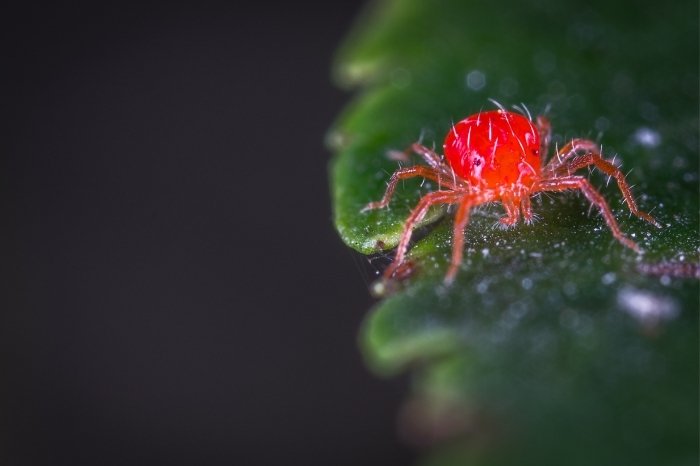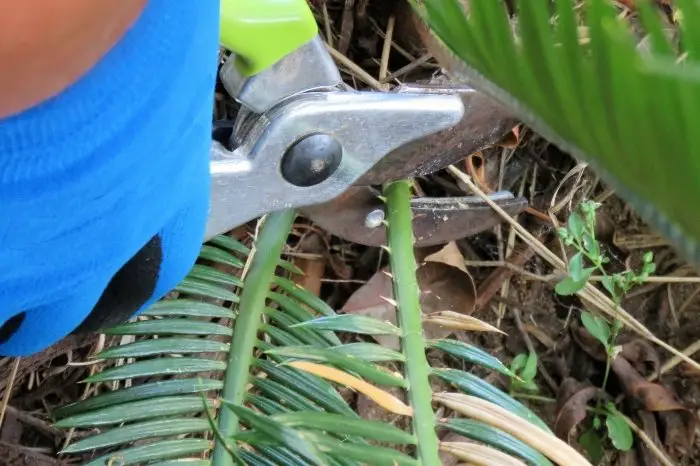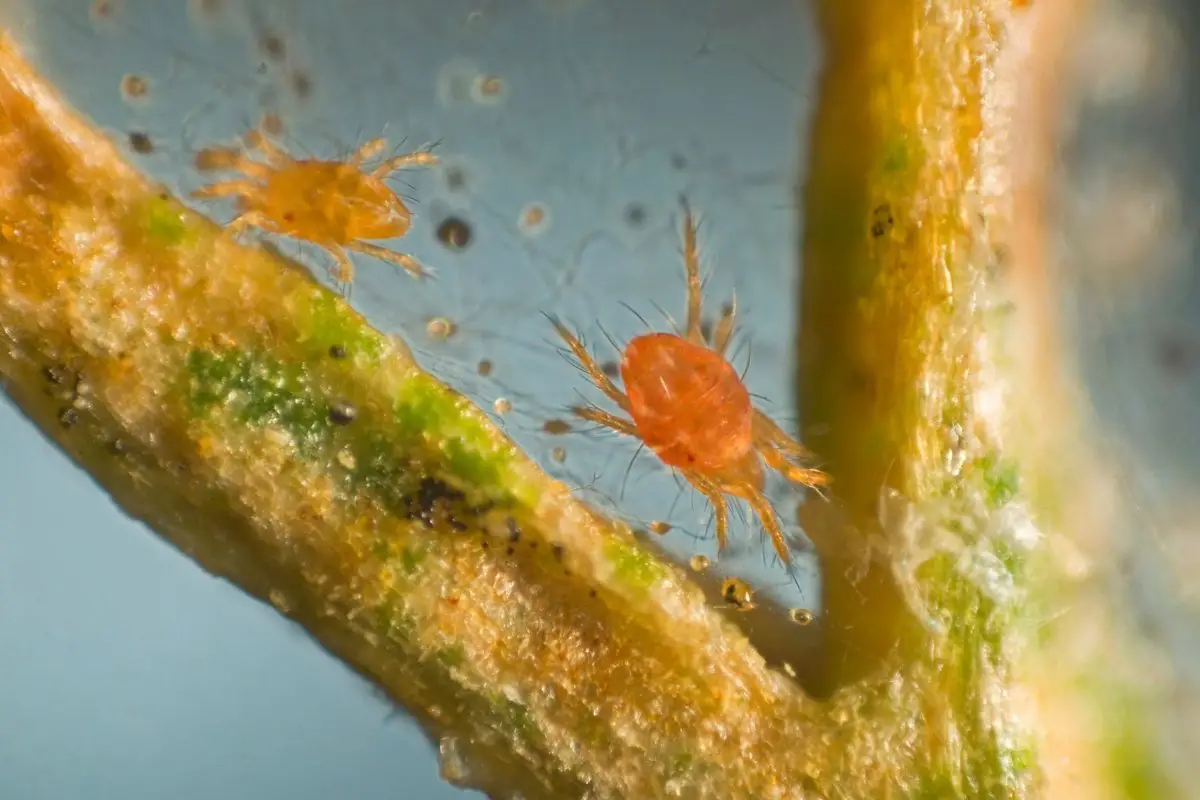Last Updated on May 7, 2022 by Griselda M.
Pests like palm spider mites can easily go unnoticed until your plant suffers tremendous damage. Their removal is easy, but it’s essential to notice the infestation on time. Spider mites attack over 200 types of plants but are no harm to humans and pets.
They live on both indoor and outdoor plants, but when outdoors, predators keep their number lower. Since tropical plants like the different types of palms are usually kept inside, keeping the palm spider mites away is in your control. Ready on to learn how to recognize an infestation and how to get rid of these pests.
What Are Spider Mites
Spider mites resemble tiny insects, but they’re actually arachnids. They belong in the same group with scorpions, ticks, and regular spiders. Spider mites are less than 1/20 of an inch in size. They can’t be seen with the naked eye, but their web is easy to spot.
They will often weave a web under the leaves to protect themselves and their larvae. You can spot this web easier than their bodies.
In the cooler months, they hide in the soil. As temperatures rise, they move to the plant’s trunk, stem, and leaves. A place with low humidity is an ideal breeding ground for palm spider mites.
Spider mites survive out of the plant’s sap. They feed by puncturing the leaves of the host plant. The damage they can cause increases with the time they spend on the plant.
Read about Do Bamboo Plants Need Sunlight To Grow?
Why Spider Mites Attack Palm Trees
Spider mites are attracted to specific plants, and palms are one of their favorites. Ornamental plants with rich foliage are both a great hiding spot and a good treat for the pests. Even though indoors they’re go for your palm spider mites outdoors live and breed on tomatoes, strawberries, and melons!
Plants positioned in bright light, and those with new leaves are very attractive to spider mites. They also prefer plants rich in carbohydrates, nitrogen, and phosphorous.
Check Out A Deeper Study Of Jade Plant roots
Detecting Spider Mites On Palm Trees
The first telltale of palm spider mites is webbing under the leaves of the palm. Since the pests are so small, they’re not noticeable to the naked eye. Instead, take a magnifying glass and inspect the leaves and stems. The spider mites are tiny dots that can be red, brown, or pale.
The second sign is brown spots on your plant’s leaves. This is because the spider mites have poking mouths with which they pierce the leave and feed. This section turns brown since the pest takes up the moisture and nutrients.

Always start by checking under the leaves, and don’t skip hydroponic plants. Even though they love to hide in soil, palm spider mites can attack plants living or propagating in water.
Get Rid Of Spider Mites Palm Pests
There are far more horrible pests to deal with, but you shouldn’t leave palm spider mites untreated. Here are our suggestions, starting with the least invasive for a small infestation.
1. Shower The Plant
The size of the spider mites suggests that you don’t need much force to physically remove them. Take your palm outside and give it a good hose down with medium pressure, trying not to damage any tender parts.
If you don’t have a garden, shower your plant. Use your shower head to bust the spider mites from the leaves.
2. Spray Diluted Dish Soap
Dilute gentle dish soap in a large water bottle with a spray nozzle. Use 0.5oz dish soap to 17oz water. Test the solution to one leaf and leave it for a day. If there are no signs of damage, spray the whole plant or use a damp towel to wipe each leaf individually.
Dish soap is very effective when it comes to tiny pests. The ingredients effectively damage the membrane of the pest leading to death. You might need to repeat this step twice a week until all palm spider mites are gone.
Safer Brand 5118-6 Insect Killing Soap Concentrate 16oz
3. Wipe With Rubbing Alcohol
Rubbing alcohol can seem too aggressive, but a solution of 50% rubbing alcohol and 50% water can get rid of the mites fast. If your palm tree leaves are too small, you can use cotton swabs to wipe them. Otherwise, use a cloth to wipe each leaf with the solution. Leave the plant for a week and repeat if needed.
4. Use Horticurtular Oil
Neem oil has great efficiency when it comes to pests removal. This horticultural oil is useful in killing an infestation and preventing a new one. Dilute it per instructions and wipe the leaves. Repeat the process once a week until there are no more palm spider mites.
Keeping Your Palm Tree Spider Mites Free
Your palm can breathe easily since the palm spider mites are gone. But preventing a new infestation is equally important. Here’s what you can do to keep your plant pest-free.
Prune The Damaged Leaves
Remove any damaged leaves that have been destroyed by spider mites feeding off of them. They won’t go back to normal, they don’t produce food, and the plant is only wasting energy keeping them alive.
Use sterilized shears and cut near the stem and discard them in the trash, not your compost.

Regularly Spray With Insecticidal Soap
Get your hands on insecticidal soap and dilute it per the manufacturer’s instructions. Patch test the solution on a single leaf and use it on the whole plant if there are no signs of damage. Be careful how you spray; the soap can ruin your floors and walls.
Introduce Ladybugs
For a completely natural solution, go for the number one enemy of palm spider mites; the ladybugs. If you don’t mind some insects around your palms, get ladybugs as the least invasive of the spider mites’ predators. But beware that you can’t use soaps and oils while ladybugs live on your palm.
Final Say: Palm Spider Mites Can Destroy Your Plant
Spider mites are tiny arachnids that live on shrubs, trees, decorative plants, fruits, and vegetable plants. Palms are among their favorite indoor plants. Palm spider mites are tiny and unnoticeable, but they tend to reciprocate fast.
These pests feed by penetrating the plant’s cells, leading to yellow and brown spots. Check your plants once a week and regularly wipe down the leaves. Apply pesticides or use a natural predator to keep the spider mites away from your palms.
Mary is a passionate gardener who loves spending her days getting her hands dirty and nurturing her plants. She‘s an avid reader of gardening magazines and is always looking for new ways to make her garden thrive. When not outside tending to her plants, Mary can be found inside reading up on the latest gardening trends, comparing notes with fellow gardeners, and finding the perfect pottery planter for her next planting project.



